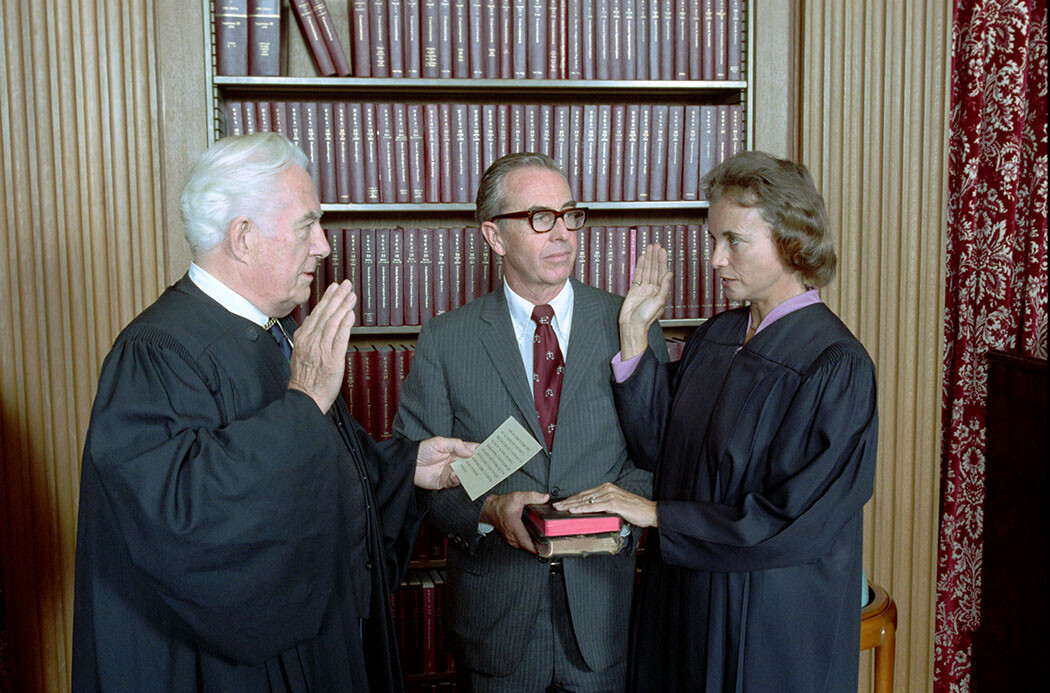
(From left) Doctoral student Hannah Yamagata, research assistant professor Kushol Gupta, and postdoctoral fellow Marshall Padilla holding 3D-printed models of nanoparticles.
(Image: Bella Ciervo)

Yesterday marked the 40th anniversary of Sandra Day O’Connor’s nomination by President Ronald Reagan to the Supreme Court, the first woman ever nominated to the nation’s highest court. Two months later the Senate unanimously approved her appointment and on Sept. 25, 1981, she was sworn in by Chief Justice Warren Burger.
O’Connor, a moderate conservative, was a key swing vote in a number of important cases until her retirement in 2006, including upholding Roe v. Wade in a 1992 case. After her retirement, she continued to be active, writing books and launching an online civics class. In 2018 she announced she had been diagnosed with dementia and said she would no longer be able to participate in public life.
Marci Hamilton, Fels Institute of Government Professor and founder and CEO of CHILD USA, clerked for O’Connor from 1989 t0 1990. Penn Today asked Hamilton to share her thoughts on O’Connor’s legacy as a legal pioneer who valued her family as much as her career.
Justice Sandra Day O’Connor, or “SO’C,” as her clerks call her, was the first woman to join the United States Supreme Court and held that position with dignity. Her strength of character made her precisely the right person to be the “first.”
The work ethic in SO’C’s chambers was intense. We were expected to produce high-quality research, certiorari pool memos, bench memos, and opinion drafts on time. We even drafted her speeches, and she was the most-requested justice in that era. During the 1989 term, there were 129 full opinions of the Court, which more than doubles the number from the most recent term, and clerks routinely worked seven days each week. I went home to Bucks County, Pennsylvania, for two days that year: Christmas and Easter.
Despite the pressures, we were held to the highest levels of professionalism. She could not be bullied into changing her mind, though Lord knows that Justice Antonin Scalia tried; I watched her rise above pettiness in her personal dealings with others as well as in her opinions for the Court.
The business of the Court was only part of what SO’C expected of us. She imposed an ethos of the “full life” in her chambers. We carved pumpkins for Halloween, visited the cherry blossoms in the spring, went to museums, and at least one clerk had to be the “exercise clerk,” who joined her for the 9 a.m. daily exercise class she organized in the building. That was me. She brought her own homemade Southwestern dishes for lunch on Saturdays before argument weeks when we would meet to discuss the cases. And family came first.
She and her husband, John, had an active social calendar in Washington, and she was often on the phone with one of her sons when I would come into her office that year. She often asked about our families and made clerk reunions family events. Her clerks’ children even have a nickname: “SO’C Grandclerk,” which is emblazoned on T-shirts.
I was blessed to be one of her clerks and, therefore, a part of her extended family.
Kristen de Groot

(From left) Doctoral student Hannah Yamagata, research assistant professor Kushol Gupta, and postdoctoral fellow Marshall Padilla holding 3D-printed models of nanoparticles.
(Image: Bella Ciervo)

Jin Liu, Penn’s newest economics faculty member, specializes in international trade.
nocred

nocred

nocred